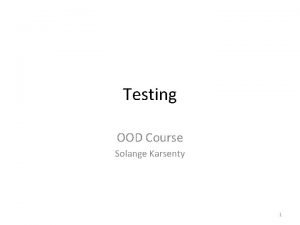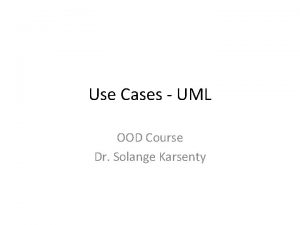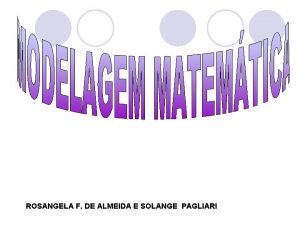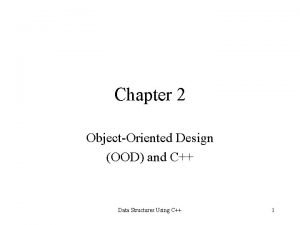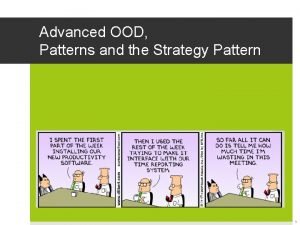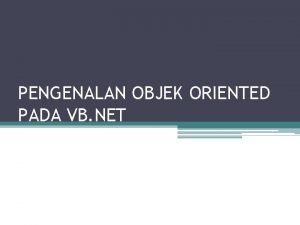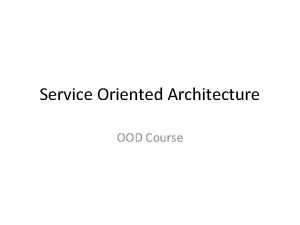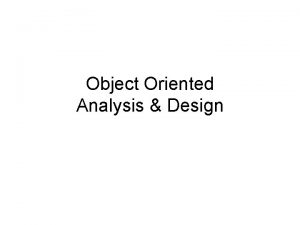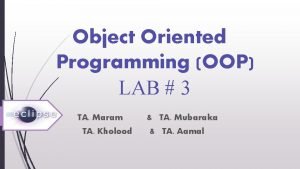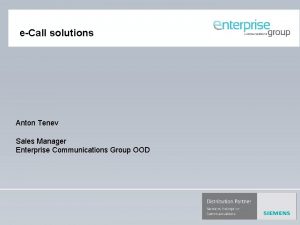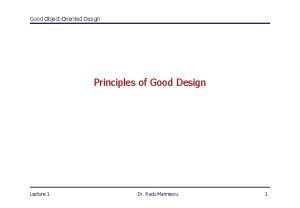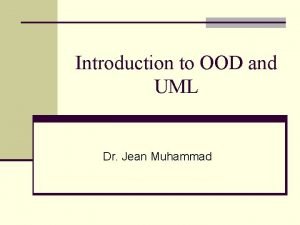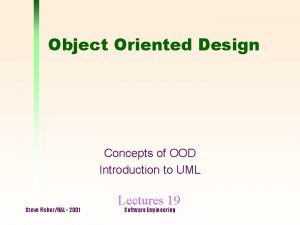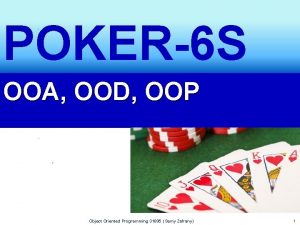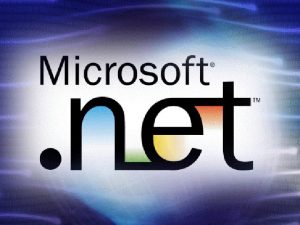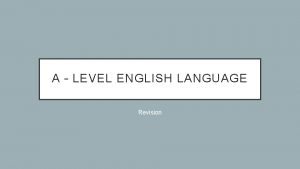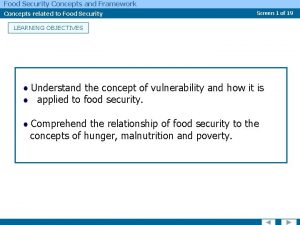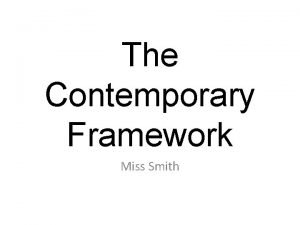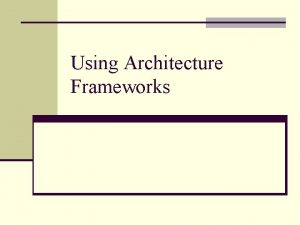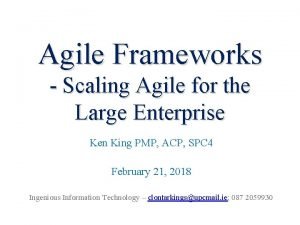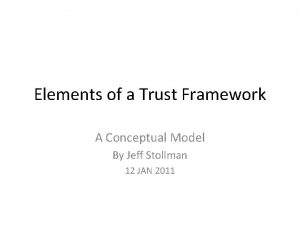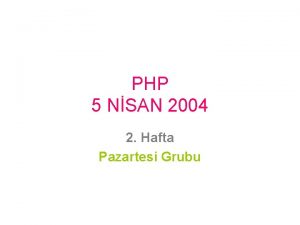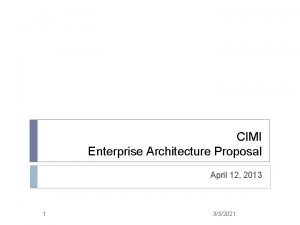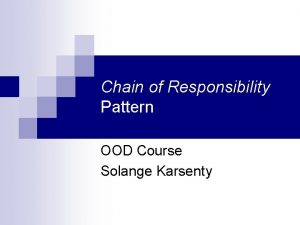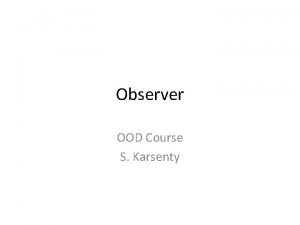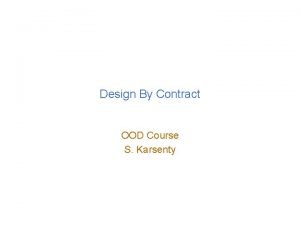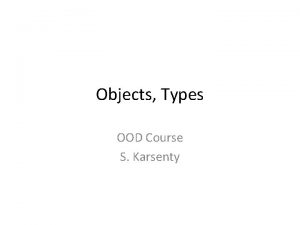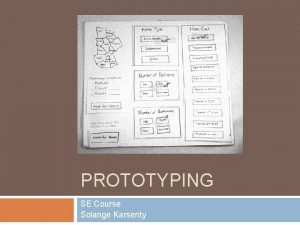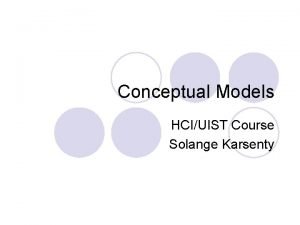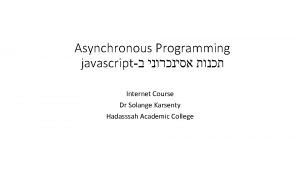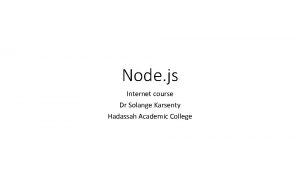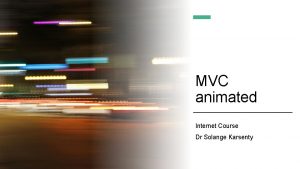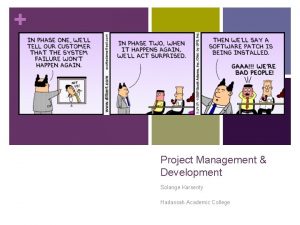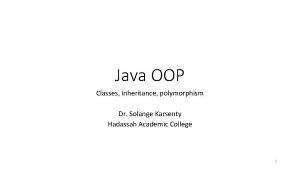Frameworks OOD Course Solange Karsenty 1 Frameworks n




















































- Slides: 52

Frameworks OOD Course Solange Karsenty

1 Frameworks n n n “A reusable, semi-complete application that can be specialized to produce a custom application” “A set of cooperating abstract and concrete classes that makes up a reusable design for a specific class of software” An Object-Oriented Reuse Technique ¨ Design Reuse + Code Reuse

A Tiny Example: Calculators ¨ interface n n n get. Value(), compute(Operator o), clear(), undo() Uses Command pattern, optionally Singleton Remembers parentheses, can iterate on their tree ¨ interface n n n ¨ All Operator Descendants: Unary. Operator, Binary. Operator Concrete classes: Plus, Minus, Power, … Acts as Command class, supports Composites ¨ interface n Calculator Visual. Calculator Observer on Calculator, can display operators on buttons, can display current computation tree are extendible, “Main” receives interfaces

Designing an OO Framework n Domain Knowledge ¨ What applications is the framework for? ¨ What is common to all of them? n Architecture ¨ Biggest, most critical technical decisions ¨ What is required besides classes? n Object-oriented design ¨ Design Reuse: Patterns ¨ Inversion of Control + Find right hooks

Domain Knowledge n n a. k. a. Analysis or Modeling Common “significant” decisions: ¨ Major concepts of the modeled domain ¨ Major operations ¨ Use cases: How users do common tasks n For example, a calculator ¨ Concepts: unary operator, binary operator, current value, in-memory value, shift key ¨ Operations: Clear, use operator, compute ¨ Use case: Computing an average of n numbers

5 Architecture n n The set of significant decisions about the structure of software, the division to components and subsystems and their interfaces, and guidelines to composing them Common “significant” decisions: n n n n Programming language, operating system, hardware Use of major external libraries or applications Physical Distribution, processes and threads Main Concepts: Kinds of modules and interfaces Communication and synchronization between modules Security Model Performance and scalability

For Example: JCA n Java Cryptography Architecture (JCA, JCE) n n n Encryption, Digital Signatures, Key Management Open for new algorithms, new implementations Main Concepts n n Provider: provides implementations for a subset of the Java Security API, identified by name Engine Classes: functionality for a type of crypto behavior, such as Signature and Key. Pair. Generator Factory Methods: static methods in engine classes that return instances of them for a given algorithm Key Store: System identity scope

JCA II n Generating a public/private key pair: n n n Key. Pair. Generator keygen = Key. Pair. Generator. get. Instance(“DSA”, “MY_PROVIDER”); keygen. initialize(key. Size, new Secure. Random(user. Seed)); Key. Pair pair = keygen. generate. Key. Pair(); Cast to DSAKey. Pair. Generator is required to initialize it with algorithm-specific parameters (p, q, g) Generating a signature: n n n Signature sha = Signature. get. Instance(“SHA-1”); Private. Key priv = pair. get. Private(); sha. init. Sign(priv); byte[] sig = sha. sign(); Provider is optional in get. Instance()

JCA III n n Although implementations will usually be non. Java, they must be wrapped in Java classes Statically, add lines to java. security text file ¨ Security. provider. Name. n = com. acme. provider. Package ¨ n is the preference order of the provider, 1 is highest n Providers can be managed dynamically too: ¨ Class Security has add. Provider(), get. Provider() ¨ Class Provider has get. Name(), get. Version(), get. Info() n Providers must write a “Master class” ¨ Specifies which implementations are offered by it ¨ There are standard names for known algorithms

JCA IV: Summary n So what does the architecture answer? ¨ Domain Knowledge: What behavior (engine classes) should be supported at all? ¨ How are different algorithms and different implementations defined and selected? ¨ How should non-Java implementations be used? ¨ How can an administrator configure a key store and a trusted set of providers and implementations? ¨ How can commercial companies sell Java-compatible closed-source implementations of security features n Not only classes and interfaces ¨ Persistent key store, config files, non-Java code ¨ Practical, management and economic considerations

Inversion of Control n n n a. k. a. The Hollywood Principle Don’t call us, we’ll call you Benefits ¨ Code reuse: Flow of control is coded once ¨ Makes it clear when and how hooks are called ¨ Produces uniformity in program behavior, which makes it easier to understand n Drawbacks ¨ Debugging is more difficult ¨ Integrating two frameworks can be hard

Hooks n Hook = Hotspot = Plug-point ¨ Points n where the FW can be customized Design issues requiring domain knowledge ¨ How to find the right hooks? ¨ Few or many hooks? ¨ What should be the default behavior? n Implementation alternatives ¨ Template Method ¨ Strategy or Prototype (Prototype: creational design ; the type of objects to create is determined by a prototypical instance, which is cloned to produce new objects) ¨ Observer

Framework Colors n White-Box Frameworks ¨ Extended by inheritance from framework classes ¨ Template Method, Builder, Bridge, Abstract Factory ¨ Require intimate knowledge of framework structure n Black-Box Frameworks ¨ Extended by composition with framework classes ¨ Strategy, State, Visitor, Prototype, Observer ¨ More flexible, slightly less efficient n Gray-box Frameworks ¨ What usually happens in real life…

Framework Colors II n n Frameworks tend to evolve to being black-box AWT 1. 0 had a white-box event model ¨ Each visual component had an handle. Event() method ¨ Each frame inherited and overrode it ¨ The method was a long switch statement n AWT 1. 1 and Swing are black-box ¨ Observer pattern: UI components publish events to registered listeners n Why is black-box better? ¨ Separation of concerns: better abstractions ¨ Important for (automatic) code generation

June 14, 2006 14 Designing an OO Framework n Domain Knowledge ¨ What applications is the framework for? ¨ What is common to all of them? n Architecture ¨ Biggest, most critical technical decisions ¨ What is required besides classes? n Object-oriented design ¨ Design Reuse: Patterns ¨ Inversion of Control + Find right hooks

June 14, 2006 15 Application Domains n System Infrastructure ¨ Operating System Wrappers: MFC, Mac. App ¨ Communication Protocols: RMI ¨ Database Access: ADO, JDO ¨ Security: JCA, JSA n User Interfaces ¨ Small. Talk-80 is the first widely used OOFW ¨ Swing, Delphi, MFC, COM… ¨ Integrated with development environments

June 14, 2006 16 Application Domains II n Middleware / Object Request Brokers ¨ Object Request Brokers: CORBA, COM+, EJB ¨ Web Services: . NET, Sun One n Enterprise Applications ¨ Enterprise = Critical to day-to-day work ¨ Usually developed inside organizations ¨ Notable Exception: IBM’s San-Francisco ¨ Java-based, reusable, object-oriented business components for commercial applications, along with an execution framework ¨ Telecomm, Manufacturing, Avionics, Finance, Insurance, Healthcare, Warehouses, Billing…

Framework Strengths n Reuse, Reuse! ¨ Design n + Code Extensibility ¨ Enables n Enforced Design Reuse ¨ An n the creation of reusable Components “Educational” Tool Partitioning of Knowledge & Training ¨ Technical vs. Applicative Specialization

Framework Weaknesses n Development effort ¨ Generic frameworks are harder to design and build ¨ They are also hard to validate and debug n Maintenance ¨ Does the FW or the app need to change? ¨ Interface changes require updating all apps n Learning Curve ¨ Unlike class libraries, you can’t learn one class at a time n n n Integratibility of multiple frameworks Efficiency Lack of standards

June 14, 2006 19 There’s Big Money Involved n All “big players” develop and sell FWs ¨ So you must use our language (Swing) ¨ So you must use our operating system (MFC) ¨ So you must use our development tool (Delphi) ¨ So you must use our database (Oracle) n There’s a component industry too ¨ Companies n that write and sell components Frameworks are an economic necessity ¨ Unwise to develop UI, DB, ORB alone today

Frameworks: Swing Case Study

Swing n Java’s User Interface FW since JDK 1. 2

June 14, 2006 22 The Problem n n Hardware and operating system support primitive I/O operations Drawing pixels and lines on the screen ¨ Class java. awt. Graphics has draw. Line(), set. Color(), fill. Rect(), set. Font(), … methods n Receiving user input ¨ Reading file and device input streams ¨ Platform-dependent

The Problem II n Visual components are not reused ¨ Should be in standard library ¨ Look-and-feel should be consistent ¨ Easy to create / buy new visual components n Design of user interface is not reused ¨ Separating visual design, data structures, user input handling and applicative code n n Code is not platform-independent A lot of code & design is required

Swing Features n Wide variety of visual components ¨ Button, Label, List, Panel, Table, Tree, … ¨ Standard Dialog Boxes (Open, Save, Color, …) n Pluggable look-and feel ¨ Platform independence ¨ Dynamically changeable n MVC architecture ¨ Facilitates n writing components or look-and-feels Action objects ¨ Shared commands in toolbars and menus ¨ Generic Undo capability

Swing Features II n Keystroke Handling ¨ Global, form, container and component shortcuts ¨ Conflict management n Nested Containers ¨ Windows, Dialogs, Frames, Panels, Tables, … ¨ Virtually anything can be in anything, at any depth n Text Manipulation ¨ HTML n and RTF editing (multi-font, colors, etc. ) Accessibility ¨ Alternative user interface support: Braille, sound…

A Simple Form The application will show this dialog box: l n n We’ll use JButton and JText. Field Inside a JPanel container Inside a JFrame (a window container) Whose main() method will run the show

27 The Simple Form Code n Step 1 is to subclass JPanel: ¨ class Simple. Panel extends JPanel { JText. Field text. Field; JButton button; public Simple. Panel() { button = new JButton("Clear Text"); add(button); text. Field = new JText. Field(10); add(text. Field); button. add. Action. Listener(new Action. Listener() { public void action. Performed(Action. Event e) { text. Field. set. Text(""); } }); }}

The Simple Form Code II n Step 2 is to subclass JFrame: ¨ public class Simple. Panel. Test extends JFrame { static final int WIDTH = 300; static final int HEIGHT = 100; Simple. Panel. Test(String title) { super(title); Simple. Panel simple. Panel = new Simple. Panel(); Container c = get. Content. Pane(); c. add(simple. Panel, Border. Layout. CENTER); }

The Simple Form Code III n The same class also contains main(): ¨ n public static void main(String args[]) { JFrame frame = new Simple. Panel. Test("Simple. Panel Example"); frame. add. Window. Listener(new Window. Adapter() { public void window. Closing(Window. Event e) { System. exit(0); } }); frame. set. Size(WIDTH, HEIGHT); frame. set. Visible(true); } } The framework takes over after main()

30 Swing Framework Structure n https: //appframework. dev. java. net/intro/index. html

31 Using the Framework n To write an application, you need to do just a few things: ¨ Extend the Application class and override its startup() method. Your startup method should create and show the application's initial GUI. ¨ when the user closes the last top level window, call Application. exit(). This causes the application's exit. Listeners to run and eventually calls Application. shutdown(). ¨ In your main method, call the static Application. launch method. This constructs and starts your Application subclass on the event dispatching thread. https: // ¨ Ref: appframework. dev. java. net/intro/index. html http: //www. netbeans. org/kb/60/java/gui-saf. html

32 Example public class Application. Example 1 extends Application { JFrame main. Frame = null; @Override protected void startup(String[] ignore. Args) { JLabel label = new JLabel("Hello World", JLabel. CENTER); label. set. Font(new Font("Lucida. Sans", Font. PLAIN, 32)); main. Frame = new JFrame(" Hello World "); main. Frame. add(label, Border. Layout. CENTER); main. Frame. add. Window. Listener(new Main. Frame. Listener()); main. Frame. set. Default. Close. Operation(JFrame. DO_NOTHING_ON_CLOSE); main. Frame. pack(); main. Frame. set. Location. Relative. To(null); // center the window main. Frame. set. Visible(true); } private class Main. Frame. Listener extends Window. Adapter { public void window. Closing(Window. Event e) { exit(e); } } public static void main(String[] args) { launch(Application. Example 1. class, args); } }

The Framework in Action n Inversion of Control ¨ Event loop is handled by a Swing thread ¨ Hardware- and OS-specific input formats are translated to standard interfaces n Hooks ¨ Building the visual controls is white-box style ¨ Registering to events is black-box style n Design Patterns ¨ Composite: JPanel. add(Component c) ¨ Observer: JButton. add. Action. Listener(al)

Patterns in Swing n Command ¨ All text editors shared some commands (cut, paste) ¨ These are encapsulated in Action objects ¨ Each text components supports get. Actions() ¨ Action objects are globally shared, and are used on menu items, toolbars and shortcuts n Strategy ¨ The Look. And. Feel interface has several heirs ¨ The UIManager singleton points to the current one ¨ It has methods to dynamically change look and feel

35 (command: reminder) objects are used to represent actions

36 (strategy: reminder) algorithms can be selected at runtime

Pluggable Look and Feel 37

Pluggable Look and Feel String os. Name=System. get. Property("os. name"); Look. And. Feel app. Look. And. Feel; if (is. Match("Windows", os. Name)) { app. Look. And. Feel=new Windows. Look. And. Feel(); } else if (is. Match("Solaris", os. Name)) { app. Look. And. Feel=new Motif. Look. And. Feel(); } //. . . other cases else { app. Look. And. Feel=new Metal. Look. And. Feel(); } UIManager. set. Look. And. Feel(app. Look. And. Feel); 38

Patterns in Swing II n State ¨ JEditor. Pane is a visual editor that supports reading and writing files in multiple formats ¨ Each format is represented by an Editor. Kit that registers with the JEditor. Pane ¨ Upon reading a file, its format is used to select an Editor. Kit for it ¨ That kit is used to read, write, list actions, … n Prototype ¨ Editor Kits are created by cloning the prototype ¨ However, this is done by reflection on class name

Patterns in Swing III n Builder ¨ Editor Kits act as builders: their input is the hierarchical Document interface ¨ Their output is the View interface: has paint method, can layout, translate coordinates, … n Abstract Factory ¨ interface View. Factory creates views ¨ Two heirs: HTMLView. Factory, Basic. Text. UI ¨ Another singleton n Factory Method ¨ Editor kits use factory methods to facilitate changing parser, view factory and default document

Patterns in Swing IV n n Chain of Responsibility ¨ A Key. Map is a <Key. Stroke, Action> map ¨ A text component has one or more Keymaps ¨ Custom Keymaps can be added and removed ¨ Keymap matching is by most-specific-first Command ¨ ¨ Package javax. swing. undo offers Undoable. Edit Also Abstract. Undoable. Edit and Compound. Edit classes Class Undo. Manager manages done commands Extends Compound. Edit - supports add. Edit(), undo(), redo(), set. Limit(), trim. Edits(), undo. To(), redo. To(), … 41

Model / View / Controller n The Basic User Interface Design Pattern ¨ Origin is Small. Talk 80, the first OOFW

MVC Participants n Model ¨ Data structure of displayed data ¨ Notifies observers on state change n View ¨ Paints the data on the screen ¨ Observer on its model n Controller ¨ Handles user input ¨ Changes model, which causes views to update

MVC Benefits n n Three elements can be reused separately Synchronized user interface made easy ¨ Multiple n views observe one model Models know nothing about presentation ¨ Easy to modify or create views ¨ Easy to dynamically change views n More efficient ¨ Shared models & controllers save memory ¨ Easy to maintain pools of views and models

Document / View n View and Controller are often merged MFC: “Document” and “View” ¨ Swing (Text Editors): “Document” and “View” ¨ Swing (Components): “Model” and “UI” ¨

MVC Inside a Component n Each component is a façade for two objects ¨ Each components defines get. Model() and get. UI() ¨ Usually one component per model and delegate n UIManager is a singleton ¨ Holds n current look & feel properties Component. UI defines drawing interface ¨ javax. swing. plaf. * includes Button. UI, Slider. UI, …

Swing and MVC n n There are several levels of using MVC “Manually”, to synchronize complex views ¨A n file explorer, with a tree and current dir In forms or complex components ¨ Custom form logic to synchronize its field ¨ A table or tree and its sub-components ¨ A variation of the Mediator design pattern n Event-handling at the application level

48 The Façade Pattern n A flexible framework becomes very complex It is important to provide simple façades JEditor. Pane class ¨ No need to know Editor. Kit & its subclasses, Document, Element, View. Factory, Key. Map, … n JButton class ¨ No need to know Component. Model, Component. UI, UIManager, Look. And. Feel, … n Provide users only with concepts they know ¨ Button, Window, Action, Menu ¨ X Document, View. Factory, Editor. Kit

49 The Façade Pattern Facade: The facade class interacts Packages 1, 2, and 3 with the rest of the application. Clients: The objects using the Facade Pattern to access resources from the Packages: Software library / API collection accessed through the Facade Class.

June 14, 2006 50 Other Features n Swing supports several other features that we don’t have time to cover: ¨ Drag & Drop ¨ Printing ¨ Internationalization ¨ Trees and Tables ¨ Menus & Popup menus ¨ Layout Management n Other standard Java graphic libraries: ¨ 2 D drawing, 3 D drawing, Multimedia Object Oriented Design

Summary n Swing is a classic OOD framework ¨ Contains a lot of domain knowledge ¨ Highly customizable through design patterns ¨ Comes with a set of implemented components ¨ Also intended for writing new ones ¨ Inversion of control + hooks n It’s a medium-sized framework ¨ Several hundred classes and interfaces ¨ Plus free & commercial 3 rd party components
 Karsenty
Karsenty Karsenty
Karsenty Uml ood
Uml ood You live and learn
You live and learn Solange du deine füße unter meinem tisch hast
Solange du deine füße unter meinem tisch hast Hadasha escobar 04
Hadasha escobar 04 Solange quer construir um muro
Solange quer construir um muro Maria solange maqueo
Maria solange maqueo Solange valenzuela
Solange valenzuela Solange die erde steht
Solange die erde steht 476 a 1453
476 a 1453 Ood in c++
Ood in c++ Ood patterns
Ood patterns Apa itu ood
Apa itu ood Ood and soa principles
Ood and soa principles Generic components of ooa model
Generic components of ooa model Ooa to ood
Ooa to ood Ood maram
Ood maram Ood
Ood Principles of good design
Principles of good design Jean muhammad
Jean muhammad Ood concepts
Ood concepts Difference between ooa and ood
Difference between ooa and ood Stretcher bond t junction
Stretcher bond t junction Course title and course number
Course title and course number Chaine parallèle muscle
Chaine parallèle muscle Net frameworks 4
Net frameworks 4 Regional construction frameworks
Regional construction frameworks Social studies toolkit
Social studies toolkit Nursing theories
Nursing theories Example of topic sentence
Example of topic sentence Executional framework
Executional framework Gary ives west yorkshire study
Gary ives west yorkshire study Nursing informatics theories, models and frameworks
Nursing informatics theories, models and frameworks Local development frameworks
Local development frameworks Food security concepts and frameworks
Food security concepts and frameworks Java ecommerce frameworks
Java ecommerce frameworks High art vs low art
High art vs low art Interpretive frameworks
Interpretive frameworks Software architecture frameworks
Software architecture frameworks Enterprise agile frameworks
Enterprise agile frameworks Knowledge frameworks
Knowledge frameworks Describe trust frameworks.
Describe trust frameworks. List of theoretical frameworks
List of theoretical frameworks Parcc model content frameworks
Parcc model content frameworks Slidetodoc
Slidetodoc Interpretive framework
Interpretive framework I hate frameworks
I hate frameworks Arnoldo hax
Arnoldo hax Ethical framework
Ethical framework Actor frameworks
Actor frameworks Enterprise architecture proposal
Enterprise architecture proposal A foundation course in human values and professional ethics
A foundation course in human values and professional ethics
